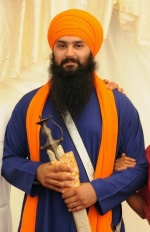Amritdhari: Difference between revisions
No edit summary |
|||
| Line 19: | Line 19: | ||
== Becoming Amritdhari == | == Becoming Amritdhari == | ||
[[File:Amritdhari.jpg|thumb|150px|right|Blue & Orange Homespun Clothing (Amritdhari)]] | |||
All Amritdhari have to be perfect for becoming Holy Sikh | All Amritdhari have to be perfect for becoming Holy Sikh | ||
Revision as of 09:37, 5 November 2015
|
Sikhism does not endorse caste based distinctions in society that lead to unequal opportunities for some people. In fact, Sikhism completely rejects class or race based distinctions between humans, that leads us to make an inequitable society. Such distinctions have surfaced only due to ill interests of certain section of people, who, on the pretext of making a society more manageable through these classifications, eventually paved the way to an unequal grouping within the human race. This article is just for information purpose and to share how people from different castes came into the Sikh fold. So, please treat this article as a source of general information about this issue and kindly do not amend this article to highlight this important underlying Sikh principle. If you have any comments, please discuss them appropriately here |
| Castes & Tribes | |
| Amritdhari | |
| Classification | Holy Sikh |
| Subdivisions | Holy Sikhism |
| Significant populations in | India, UK, Europe |
| Languages | Punjabi, Hindi other Eurpoean languages |
| Religions | Sikhism, Hinduism, Islam |
A Sikh who has taken part in the Amrit ceremonial or initiation into the Khalsa.
Sikh Citizens don't believe in caste citizens are Amritdhari, its very hard become Amritdhari not an easy task
Amritdhari
Amritdhari which means 'pure' is the name given by Guru Gobind Singh to all Sikhs who have been baptised or initiated by taking Amrit in a ceremony called Amrit Sanchar, citizen singh or kaur abides by these vows and follows the "panj kakari rahit" (rules of the wearing the Five ks), the distinctive insignia introduced by the Guru on that day comprising five symbols each beginning with the Gurmukhi letter "ਕ" (pronounced "kakka") or its Roman equivalent "k". These are kesh (long unshorn hair and in case of men, uncut beard), kangha (a comb to keep the hair tidy), kirpan (a sword), kara ( a steel bracelet worn about the wrist), and kaccha (a short undergarment).
Amritdhari Appearance
Amritdharis are easily recognized by their practice of wearing blue and orange homespun clothing and by their method of tying the turban around across the forehead. Around their necks they wear a blue woolen cord (mala), woven as a series of 1 knots and serving as a rosary
Becoming Amritdhari
All Amritdhari have to be perfect for becoming Holy Sikh
- Amritdhari all ways wear 5Ks and blue and orange homespun clothing
- Amritdhari no caste and surname involved, strict to singh and kaur
- Amritdhari only can eat in Sanchar Phandee, no one else is cups and plates
- Amritdhari attending and metting new amrithari friends in gurdwaras
- Amritdhari going to gurdwara after work, pray seven days a week
- Amritdhari attending punjabi lessons reading and writing in Punjabi
- Amritdhari attending and performing kirtan and shabad in gurdwaras
- Amritdhari attending and performing sikh everts and sikh channel
- Amritdhari can not touch meat or eat meat, only strict to vegetarian
- Amritdhari can not drink alcohol, only strict to water or soft drinks
- Amritdhari can not smoke or take any illegal drugs, only strict to bubblegum
- Amritdhari only can marry amritdhari, no caste only amritdhari
The Beginning of the Amritdhari
Although the word "Khalsa" existed before 1699, it is accepted that the Khalsa panth or Khalsa movement was started by the tenth Sikh Master. In the Sikh Holy book, called the Guru Granth Sahib, Bhagat Kabir uses the word "Khalsa" for the first time in Sikh sacred literature. The tuk (line) that contains this word is:
| ਪਰਿਓ ਕਾਲ ਸਭੈ ਜਗ ਊਪਰ ਮਾਹਿ ਲਿਖੇ ਭਰਮ ਗਿਆਨੀ ॥ ਕਹ ਕਬੀਰ ਜਨ ਭਝ ਖਾਲਸੇ ਪਰੇਮ ਭਗਤਿ ਜਿਹ ਜਾਨੀ ॥੪॥੩॥ |
| Pario kĝl sabẖai jag ūpar mĝhi likẖė bẖaram giĝnī. Kaho Kabīr jan bẖaė kẖĝlsė parėm bẖagaṯ jih jĝnī. ॥4॥5॥ |
| Death has fallen on the whole world; the doubting religious scholars are also listed on the Register of Death. Says Kabeer, those humble people become pure - they become Khalsa - who know the Lord's loving devotional worship.॥4॥5॥ |
However, the most radical change in the Sikh faith was instigated when Guru Gobind Singh in 1699, holding a kirpan (sword), asked a crowd of Sikhs whom among them would give his head for his sword which he said was thirsty for blood and die for their faith. He asked for a volunteer to step forward and follow him into his tent. After a few moments of astonished hesitation one lone brave man followed his Guru into the tent. A few seconds later only the Guru emerged holding his sword, dripping with fresh blood. Asking for another volunteer another man stepped forth, one by one the brave men strode into the tent, each of a different caste, each ready to be slaughtered for his faith in his Guru. It was then that the crowd found out that none of the five men were actually killed, and these five men became the Panj Piyare.
As they were baptised so then they were asked in turn to baptise the baptiser himself — Guru Gobind Singh. And so since that historic day have the Panj Piyare the (Five Pure Ones) baptised all the others who have taken up the "Five Ks" and the other requirements and joined the brother/sisterhood of the Khalsa.

